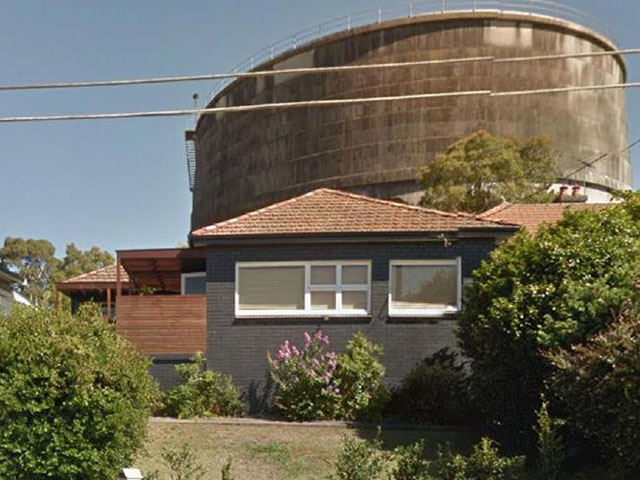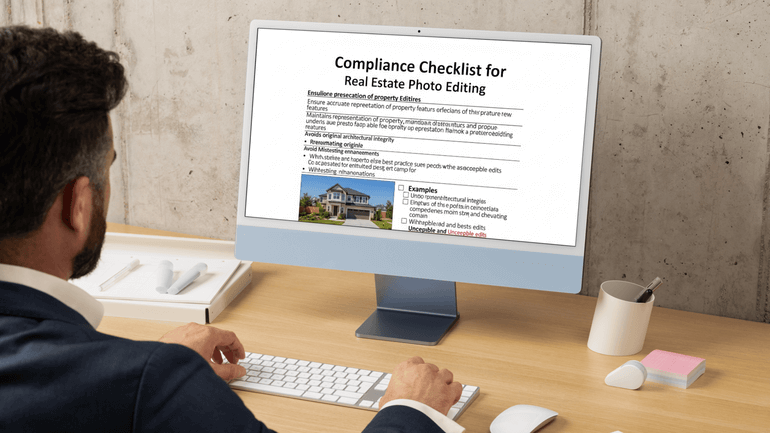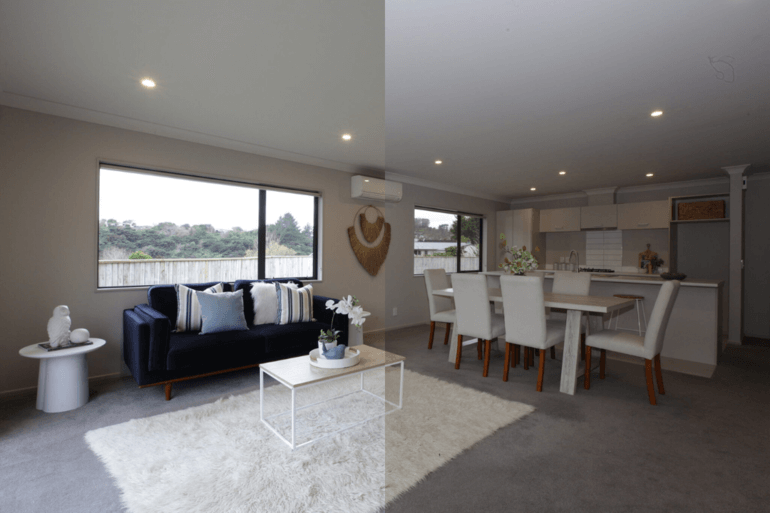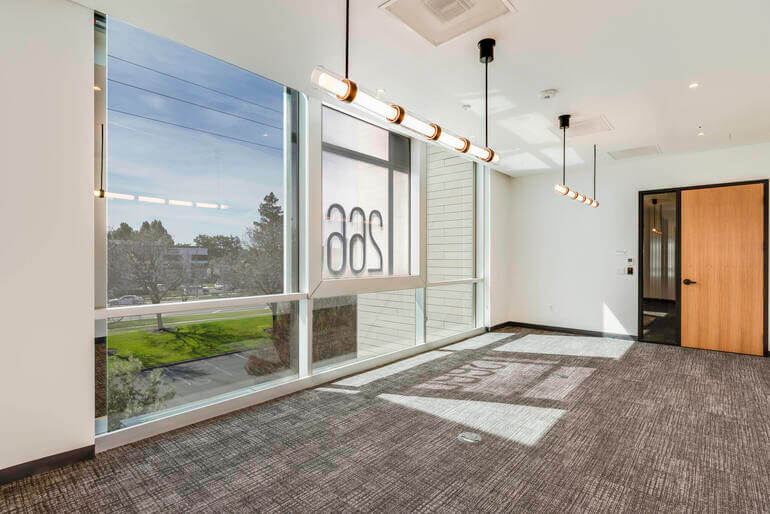Table of Contents
- Why Legal Compliance Matters in Photo Editing
- What You Can and Cannot Edit
- Understanding the Legal Guidelines for Photo Editing
- Best Practices for Legal and Ethical Photo Editing
- Compliance Checklist for Real Estate Photo Editing
- Need Professional and Compliant Photo Editing?
Failing to adhere to legal standards in real estate photography can lead to misleading advertising claims, ethics violations, and even lawsuits.
In this article, we’ll cover how to edit real estate photos legally and ethically, avoid common pitfalls, and maintain buyer trust—all while ensuring your listing stands out for the right reasons.
Let’s begin by taking a look at why legal compliance matters in real estate photo editing and what can happen if you don’t follow legal guidelines.
Why Legal Compliance Matters in Photo Editing 📸
Real estate photo editing plays a crucial role in capturing buyer interest, highlighting a property’s best features, and generating more leads.


However, when it comes to enhancing listing photos, there’s a fine line between improving a property’s appeal and crossing into deceptive marketing.
That’s where legal compliance comes in. Overly edited or misleading images can:
- Violate local advertising laws
- Breach National Association of Realtors® (NAR) Code of Ethics
- Damage your credibility
- Result in lawsuits from misled buyers
And most of all, misleading images will disappoint buyers and turn them away from your listing.
Instead of gaining a potential buyer, you’ll lose your chances to sell, and instead, you’ll walk away with a damaged reputation.
A Real Case Study:
In 2019, a listing in California received backlash when the sky in the photo was digitally altered to look sunnier, and a major power line was removed. The buyer felt misled upon visiting the home and filed a complaint citing false representation.
We don’t want this to happen to you, so let’s move on to what you can and cannot edit when touching up your real estate photography.
What You Can and Cannot Edit

Recent studies show that professional visuals can help homes sell 32% faster and at higher prices, as buyers are more likely to be drawn to listings that showcase properties in the best possible light.
In other words, enhancing your real estate photography to create high-quality images that show properties in their best light is crucial to selling listings faster and at premium rates.
But to stay compliant, you need to understand the difference between acceptable photo enhancements and misleading photo manipulations.
Examples of Acceptable Real Estate Photo Edits


To begin, here are some common acceptable real estate photo edits:
- Brightening or adjusting exposure
- Adjusting white balance
- Color correction
- Straightening lines (e.g., correcting perspective distortion)
- Lawn greening for dead grass during off-season
- Sky replacement with natural lighting consistency
- Decluttering (removal of trash cans, cords, etc.)
- Day-to-dusk conversion
- Window masking
- Noise reduction and sharpening
- HDR blending
- Virtual staging (when properly disclosed)
- And more!
Examples of Misleading or Illegal Photo Edits


In contrast to the typical image enhancements allowed, here are some edits that can get you in legal hot water:
- Removing permanent objects like power lines or water towers
- Editing out property damage (e.g., cracks, stains, mold)
- Misrepresenting room size or layout through wide-angle distortion
- And digitally altering views (e.g., adding oceanfronts, mountains)
While acceptable edits enhance a listing’s appeal, it’s essential to draw the line at manipulations that misrepresent the property, as these can lead to legal issues and erode buyer trust.
With this in mind, let’s help you understand the legal guidelines when marketing real estate.
Understanding the Legal Guidelines for Photo Editing ⚖️
Different countries and states have their own legal standards for what’s allowed in real estate marketing. However, many guidelines follow the basic principles of “truth in advertising”.
These basic legal guidelines include:
| Federal Trade Commission (FTC) Standards: The FTC regulates advertising, and any photo used to sell a product—homes included—must not be “unfair or deceptive.” Misleading enhancements could be considered a violation under this rule. |
| State Real Estate Commissions: Most U.S. states, such as California’s Bureau of Real Estate, have strict rules about advertising accuracy. Agents are held accountable for misleading visuals just as they are for written misrepresentations. |
| MLS (Multiple Listing Service) Guidelines: Many MLSs have specific rules about the use of photos. For example, MLS Listings in California prohibit altering photos to hide property flaws. |
| NAR Code of Ethics: Standard of Practice 12-10 under Article 12 of the NAR Code of Ethics states: “REALTORS® shall present a true picture in their advertising, marketing, and other representations.” |
Failure to comply could lead to disciplinary action, including fines or suspension.
So, how to ensure ethical editing? Let’s take a look at some best practices in real estate photo editing.
Have You Ever Thought To
Outsource Photo Editing?
Try it today with 10 free edits from three professional photo editors.
Best Practices for Legal and Ethical Photo Editing 🧰


To keep your real estate photo editing both impactful and legal, we recommend that you follow these strategies:
1. Stay True to Scale and Proportion
When shooting real estate photography, use wide-angle lenses responsibly.
Overextending can make small rooms look massive, creating a misleading representation.
2. Disclose Virtual Staging or Edits
Virtual staging is a groundbreaking tool used to digitally furnish empty or outdated spaces to show the home’s full potential.
It helps create an emotional connection to the space, and potential buyers can imagine themselves living in the home.
If a photo is virtually staged, labeled enhancements like “Virtually Staged,” “Digitally Staged,” or “Virtual Furniture Added” should be clearly noted.
Here’s an example of disclosure text for digitally altered images:
“This image has been virtually staged to show the potential of the space.”
For more information and examples of disclosures, you can check out our blog post on MLS-compliant virtual staging.
3. Stick to Cosmetic Touch-Ups Only
63% of real estate agents acknowledge that high-quality photography is essential to their success and the sale of properties.
To create clean listing photos without the interference of the seller’s personal belongings, object removal is essential.
It’s okay to remove temporary clutter, such as:
- Pet bowls and toys
- Messy cords and wires
- Trash bins
- Outdated furniture and wall art
- Or, cars in the driveway
But editing out structural defects or mold patches? Absolutely not!
4. Use Natural-Looking Sky Replacements
Sky replacements are an industry-standard practice that enhances curb appeal without misrepresenting the home.
Replacing a dull sky is fine if the new sky realistically matches the lighting and tone of the property’s natural setting.
As long as the structural elements remain unchanged, such edits are entirely ethical.
5. Keep an Editing Log
When working with a professional editing team, it can be good to ask them to keep an edit log.
That way, they can show you what was altered—useful in case of disputes or legal questions.
Examples of Compliant vs Non-Compliant Edits
To give you a better idea of what’s allowed and considered misleading, we’ve created this example of compliant vs non-compliant editing techniques:
| Edit Type | Compliant Example | Non-Compliant Example |
| Sky Replacement | Replacing overcast sky with a clear, naturally lit sky | Adding a sunset or fake mountains, not visible from the property |
| Object Removal | Removing a parked car or trash bin | Removing telephone poles or neighboring buildings |
| Virtual Staging | Adding digital furniture and decor with a clear label | Virtually renovating kitchen cabinets with no disclosure |
| Perspective Correction | Straightening leaning verticals | Stretching the room depth to make it look larger |
What Happens If You Break the Rules?
So, what happens if you break the rules? Violations—intentional or not—can lead to serious consequences such as:
- Loss of License or NAR Membership: A false representation could breach your local real estate commission’s ethics code or NAR standards
- Civil Lawsuits: A buyer can file a lawsuit claiming fraud or misrepresentation if they believe the listing photo caused them to make a bad purchase
- Reputational Harm: Word travels fast in real estate. Once agents are known for misleading marketing, it becomes harder to win listings and close deals
In short, bending the truth in your listing photos isn’t just risky—it can cost you your license, your reputation, and your livelihood.
Final Thoughts: Accuracy Builds Trust
The goal of real estate photography is to enhance appeal—not alter reality. Buyers want to be wowed, but also reassured that what they see is what they’ll get.
Legal compliance in photo editing isn’t about limiting creativity—it’s about fostering transparency, trust, and professionalism in every transaction.
So brighten those photos, straighten those walls, and showcase your listings beautifully—just keep it honest, ethical, and in compliance with the law.
Here’s a compliance checklist to help you out.
✅ Compliance Checklist for Real Estate Photo Editing

Before publishing any real estate images, run through this quick checklist:
- Have I avoided altering or hiding permanent features?
- Have I disclosed any virtual staging or edits?
- Are room proportions accurate and not exaggerated?
- Have I only made cosmetic improvements (e.g., brightness, minor clutter)?
- Does the photo reflect what a buyer would see in person?
- Is the edited image consistent with the listing description?
- Have I reviewed MLS and local real estate board guidelines?
Before we leave this topic, let’s take a look at an even easier solution to ensure legal compliance by outsourcing your post-processing to PhotoUp!
The Real Estate Photography
Business Systems You Need
PhotoUp is the ultimate real estate photographer business platform.
Need Professional and Compliant Photo Editing? 👩💼


If you’re looking for a trusted, ethical, and experienced real estate photo editing team, PhotoUp is your go-to service.
With a team of professional photo editors trained specifically in real estate photography, PhotoUp ensures your images look professional—without being misleading.
Browse Top Dedicated
Real Estate Photo Editors
Ready-to-hire editors for real estate photo editing, and more.
We can help you with real estate photo editing techniques, such as:
- Brightness and contrast adjustments
- Day-to-dusk conversion with natural sky replacements
- Lawn greening, object removal, and HDR blending
- Perspective and color correction
- Flambient editing
- Floor plans
- Virtual staging with clear disclosures
- And much more!
All edits are in strict compliance with NAR, MLS, and FTC guidelines.
With prices starting at just $1.50 per image for on-demand editing and fast turnaround times of 12-24 hours, you can save time, reduce liability, and attract more buyers—legally.
A Complete Real Estate Marketing Service


Additionally, PhotoUp is more than just photo editing! We also offer other powerful real estate marketing services like:
- Virtual staging
- Virtual house tours
- Single property websites
- House portraits
- Property flyers
- And floor plans
Having access to all these marketing tools on one platform allows you to expand your product offerings and become more valuable to your clients.
Together with PhotoUp, you can quickly grow and scale your business while also staying compliant.
How to Get Started
Getting started with PhotoUp is super easy! Here’s what to do:
Step 1. Sign up for a free PhotoUp account.
Step 2. Upload your photos to our easy-to-use software.
Step 3. Choose the level of editing that you need and provide instructions (optional).
Step 4. Wait for PhotoUp professional editors to edit and return the photos in less than 24 hours (48 hours for virtual staging).
Step 5. Download and start using your beautifully edited photos.
As simple as that!
So, say goodbye to unethical photos and hello to natural, legally compliant images.
👉 Sign up for a free PhotoUp account today and bring your real estate photos to life — the legal way.
For a limited time, you’ll even get 10 free credits when signing up for an account that you can apply to any of our services.
We hope this blog post helped you learn how to ensure legal compliance in real estate photo editing. Before you go, you may also want to check out some related resources:






